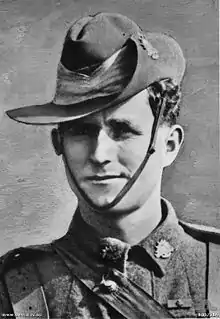John Dwyer | |
|---|---|
 Sergeant John Dwyer VC, c. 1918 | |
| 1st Deputy Premier of Tasmania | |
| In office 26 August 1958 – 12 May 1959 | |
| Premier | Eric Reece |
| Succeeded by | Roy Fagan |
| Minister for Agriculture | |
| In office 29 June 1948 – 19 September 1961 | |
| Premier | Robert Cosgrove Eric Reece |
| Preceded by | John Madden |
| Succeeded by | Alexander Atkins |
| Speaker of the Tasmanian House of Assembly | |
| In office 10 February 1942 – 29 June 1948 | |
| Premier | Robert Cosgrove Edward Brooker |
| Preceded by | David O'Keefe |
| Succeeded by | Peter Pike |
| Member of the Tasmanian House of Assembly for Franklin | |
| In office 9 May 1931 – 17 January 1962 | |
| Personal details | |
| Born | John James Dwyer 9 March 1890 Port Cygnet, Tasmania |
| Died | 17 January 1962 (aged 71) Bruny Island, Tasmania |
| Nationality | Australian |
| Political party | Labor Party |
| Military service | |
| Allegiance | Australia |
| Branch/service | Australian Imperial Force |
| Years of service | 1915–18 |
| Rank | Lieutenant |
| Battles/wars | First World War |
| Awards | Victoria Cross |
John James Dwyer, VC (9 March 1890 – 17 January 1962) Commonly known as Jack or JJ, he was a politician and an Australian recipient of the Victoria Cross, the highest award for gallantry in the face of the enemy that can be awarded to British and Commonwealth forces. Elected to the Tasmanian House of Assembly in 1931 representing the Labor Party, Dwyer served as Deputy Premier of Tasmania from August 1958 to May 1959 and remained in office until his death.
When Dwyer was 27 years old he was a sergeant in the 4th Company, Australian Machine Gun Corps, Australian Imperial Force during the First World War. At that time, the following deed took place for which he was later awarded the VC.
On 26 September 1917 at Zonnebeke, Belgium, during the Battle of Polygon Wood, Sergeant Dwyer, in charge of a Vickers machine-gun during an advance, rushed his gun forward to within 30 yards of an enemy machine-gun, fired point blank at it and killed the crew. He then seized the gun and carried it back across shell-swept ground to the Australian front line. On the following day, when the position was being heavily shelled, and his Vickers gun was blown up, he took his team through the enemy barrage and fetched a reserve gun which he put into use in the shortest possible time.[1][2]
Dwyer later achieved the rank of lieutenant. His Victoria Cross is displayed at the Australian War Memorial.

References
- ↑ "No. 30400". The London Gazette (Supplement). 23 November 1917. p. 12328.
- ↑ "Sergeant John James Dwyer". www.awm.gov.au. Australian War Memorial. Retrieved 18 February 2018.
- Batt, Chris. "John James (Jack) Dwyer (1890–1962)". Australian Dictionary of Biography. via National Centre of Biography, Australian National University: Melbourne University Press.
External links
- Batt, Chris (1996). "Dwyer, John James (Jack) (1890–1962)". Australian Dictionary of Biography. National Centre of Biography, Australian National University. pp. 64–65. ISSN 1833-7538.
- "John James Dwyer – Discovering Anzacs". National Archives of Australia. Retrieved 10 October 2014.
- "Dwyer, John". Members of the Parliament of Tasmania. Retrieved 24 July 2022.